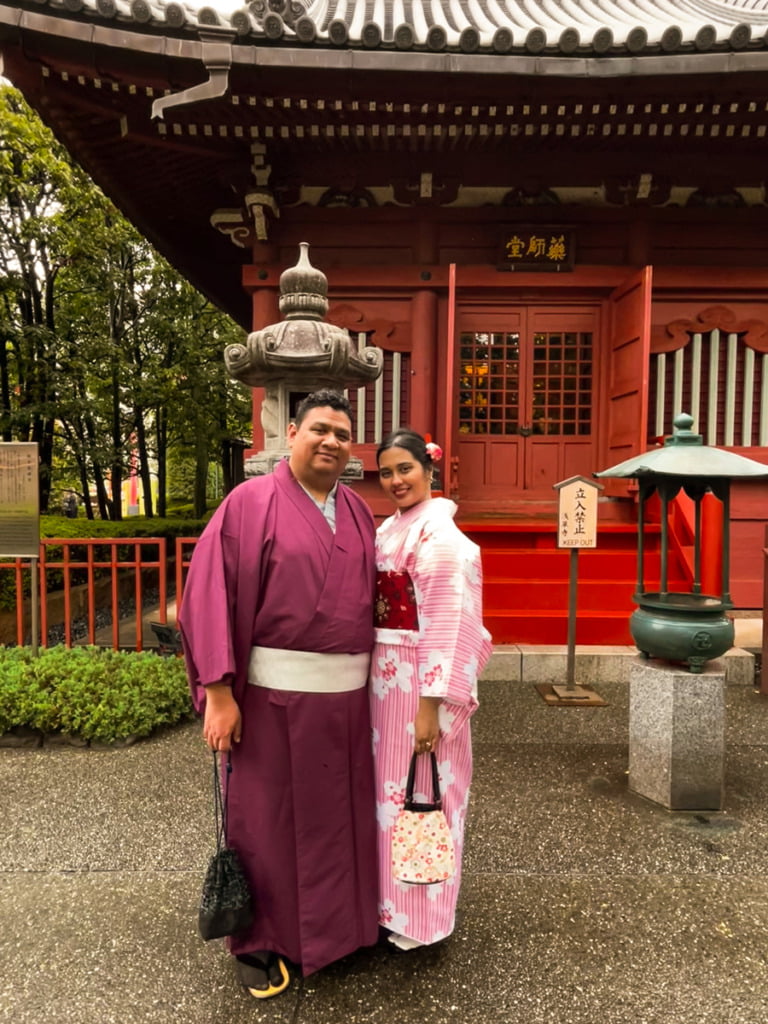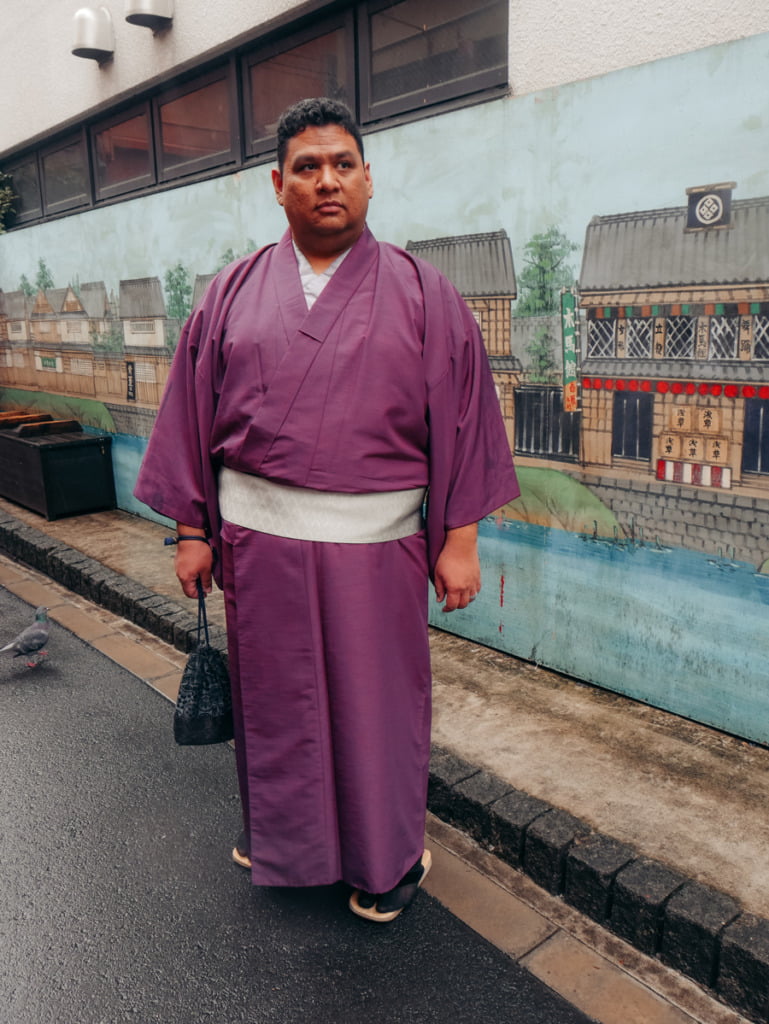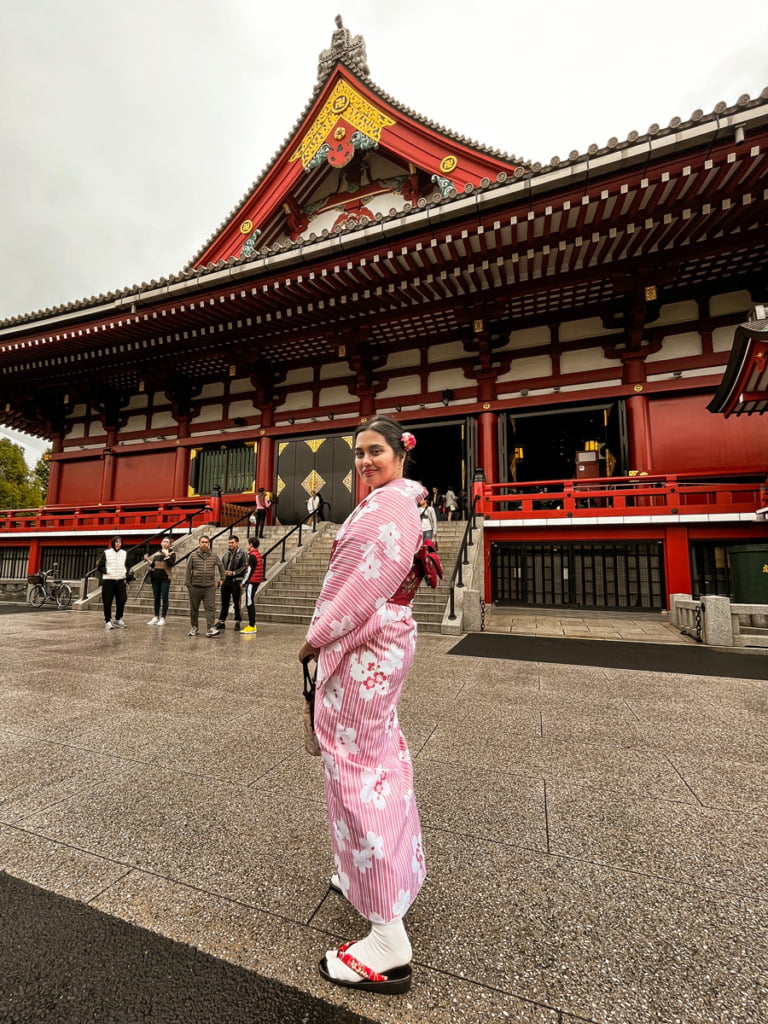Ultimate Guide to Renting a Kimono in Tokyo

When you’re visiting Japan, I can’t recommend immersing yourself in the culture head-on. One of the best ways to do that is by renting a kimono in Tokyo, specifically in Asakusa.
Asakusa is Tokyo’s historical district, most famous for Sensoji Temple and the stalls along Nakamise-dori Street. The vibe of Asakusa is completely opposite of its ultra-modern neighbors Shinjuku and Shibuya, bringing you back to Japan in the Edo period. This makes it a perfect backdrop for photos as you stroll the streets with this traditional Japanese outfit.
When Cecilio and I were planning our trip to Japan, I knew I wanted the both of us to rent kimonos, and stroll the streets of Asakusa and around Sensoji Temple. So I rented our kimonos from Kimono Rental Wargo through Viator, a small rental shop located in Asakusa Yokocho, a food hall on the 4th floor of the mall Tokyo Rakutenchi Asakusa.
For this guide, I will go over the following:
- What a kimono is, and how it’s traditionally worn
- Our experience with Kimono Rental Wargo
- Where you can also rent a kimono in Asakusa
- FAQs about renting a kimono in Tokyo

Disclaimer: This post uses affiliate links, which means I make a commission if you book through this post. If you do decide to book using my links, thank you so much for your support!
What is a kimono?
A kimono is the national dress of Japan, a traditional full-length robe. For women, they come with vibrant colors and intricate designs while men’s kimonos are solid with muted colors. They are accessorized with an obi, a wide structured belt, zōri sandals (made with rice straw, wood, cloth, and rubber), and tabi socks (which separate the big toe from the other toes to wear with the sandals).
Locals reserve wearing kimonos for special occasions such as weddings, funerals, tea ceremonies, and school graduations. These kimonos are usually made with luxurious silk costing up to millions of yen. Geishas wear kimonos on a daily basis as a part of their profession. You won’t see locals wearing them on a random day; instead, most people wearing kimonos are tourists. Usually, they are made with cheaper materials like polyester.
Renting kimonos is more popular in Kyoto because it has a historical vibe and experience, especially in Gion (Kyoto’s geisha district). However, renting a kimono in Tokyo is extremely popular too, especially in Asakusa. I like to call Asakusa the “Kyoto of Tokyo” 😉
Wearing a yukata in the summer
A yukata is a more casual version of a kimono, made with cotton and is unlined. Most people wear it during the summer due to Japan’s sweltering temperatures. A yukata is also worn as a bathrobe for the onsens (hot springs) or in the ryokans and hotels offered. I wore a yukata as pajamas during my stay at Ryokan Sakura Urushitei in Kyoto. During the summer, most kimono rental shops in Japan rent out yukatas.

Our Experience with Renting with Kimono Rental Wargo
Cecilio and I rented our kimonos at Kimono Rental Wargo. It’s on the 4th floor of Tokyo Rakutenchi Asakusa, a mall in Asakusa (it’s a few floors above Uniqlo). I booked through Viator, which made it an easier process than directly through their website.
I was a little worried about the sizing situation for me and Cecilio, especially with Japan’s much smaller clothing sizes. Thankfully, we were able to find kimonos in our size! I’m 5’4″ and I wear a size US 10/12 and a M or L, and there were still a handful of kimonos available for me.
One thing you need to know when visiting Japan is that not many people speak English, and the language barrier makes it challenging. I took two years of Japanese class in high school a looooong time ago, and I still struggled to communicate with the staff. Thankfully, one of the ladies and I could exchange conversation through Google Translate.
Actually, it was kinda funny and embarrassing that I picked out a kimono and she texted me saying, “I don’t think this one is going to fit you, can you please select another one?”
There are so many kimonos available in different colors, patterns, and designs. Additionally, there was a wall full of obi selections to complement your fit. Kimono Rental Wargo has a variety of selections for men, but nowhere near as much as women’s. There’s also a handful of children’s kimonos for those who want to doll up their little ones!
The kimono fitting process
Some of the other ladies and I did understand each other through hand gestures during the fitting (like when I needed to raise my arms or take something off). And they did understand some basic English, like when another one asked if this was my first time wearing a kimono. And of course, they would squeal “kawaii!” (meaning “cute” in Japanese) in between fittings.
During the fitting, the ladies gave me undergarments traditionally worn under the kimono. This included the hadajuban, a wrap shirt, and a susoyoke, a calf-length skirt. Both are made with cotton and hemp to absorb sweat. They then sewed the han-eri, the collar that is visible when wearing kimono, to the hadajuban.
Finally, I got my princess moment once they put the kimono on me and tied me with the obi. They then gave me the tabi socks as a gift!
Choosing a hairstyle
Unfortunately, renting with Kimono Rental Wargo doesn’t include getting your hair done, but it is an optional service that they provide. It isn’t too expensive; a standard hairstyle is 1,100 JPY ($7.37 USD) and a premium one is 2,200 JPY ($14.74 USD). I opted for the standard hairstyle, which included a kanzashi (hair accessory) of choice.
The lady who fitted and dressed me had me sit down at the vanity desk so that she could style my hair. There was a laminated sheet of paper with photos of hairstyles to choose from, so I just picked one I thought would look best on me and let the lady work her magic to complete my princess look 🙂
Completing the look with accessories
Once Cecilio and I finished our fittings, we both got to choose which handbags and sandals to wear with our kimonos. Then, we were off to explore Asakusa with our outfits! We had 6 hours to rent and spare, although we ended up wearing them for 2 hours before returning them.

Things to do in Asakusa while wearing a kimono
Honestly, anything you can do in regular clothes you can do in a kimono. For some people, however, it may feel a little constricting; that’s how it felt for Cecilio, especially with wearing the obi. Not all men wore the obi with kimono, and he would lament to me how much more comfortable it would’ve been to not have one (some of the men we passed by didn’t have an obi).
Here are a few bucket list activities and Instagram spots you shouldn’t miss while renting a kimono in Tokyo (specifically the Asakusa area):
Sensoji Temple
Visiting Sensoji Temple is a must in Tokyo, especially when donning a kimono! It is Tokyo’s oldest Buddhist temple and one of the most visited religious sites in the world, attracting more than 30 million visitors a year. The Sensoji Temple consists of the Main Hall, where you can climb a few steps to see what’s inside, including an active worship service.
The Sensoji Temple isn’t limited to the Main Hall; you can take a peek at the 5-storied pagoda, or walk past a small bridge with a koi pond on one side and a mini waterfall on the other. You can also shop along the stalls of Nakamise-dori Street, or take photos in front of Kaminarimon Gate, one of the main entrances to Sensoji! It’s a popular photo spot, especially with the large lantern hanging.

Ride a rickshaw
There are so many rickshaws all around the Asakusa area, and riding one while wearing a kimono makes for a classic traditional Japanese experience. It’s also a good way to rest and take breaks, especially because walking around with the zōri sandals can get uncomfortable after a while. I tried to convince Cecilio for us to ride it, and he wasn’t keen, even though he kept complaining about how much his feet hurt!

Eat your way through Japan
One of the main reasons to visit Japan is to pretty much eat, and it’s one of the culinary meccas of the world. You can eat wearing a kimono as long as you don’t order something messy or spill anything on it. Otherwise, you will have to pay for the mess. Cecilio ordered a bucket of fried tempura at a stall while we wore the kimonos. We saw other kimono-wearers dine at sit-down restaurants or izakayas (Japanese bars that offer small bites).
We ordered takoyaki (deep-fried octopus balls) once we returned our kimonos and went back to wearing our normal clothes since it’s a saucy dish and we didn’t want to make a mess.
Other Tokyo Kimono Rental Experiences
While Cecilio and I had a simple rental experience, there are other packages and excursions you can book in addition to renting a kimono in Tokyo.
Private Kimono Photo Tour in Tokyo
Kill two birds with one stone with this experience by renting a kimono in Tokyo AND getting a 3-hour photoshoot. Phone photos are fine, but getting high-quality photos from a professional photographer is even better! Actually, you can kill THREE birds with one stone because the photographer will act as your tour guide, taking you to some of the lesser-known spots in Tokyo. This rental shop isn’t in Asakusa; instead, it’s nearby on the other side of the Sumida River. While your photographer will take you to Sensoji Temple, they will capture you in the less-crowded areas. They will guide you and photograph you in hidden gems such as Hyakkaen Garden and Shitamachi Zones.
Keep in mind that this excursion does not provide plus-sized kimonos over 110 cm (43 in) hip size.
Kimono and Rickshaw Experience
This experience provides everything you need to get kimono-ready, including the hairstyle and the bag. Once you’re ready, a rickshaw will pick you up and you will get a commemorative photo on it before you set off the streets of Asakusa. You can get off the rickshaw anytime and explore on your own as you please!
Kimono Rentals for Plus-size
It’s challenging navigating Japan when you’re mid-sized or plus-sized, and renting a kimono is no exception. Fortunately, this rental shop has a variety of sizes for women and men, with the maximum hip size available at 130 cm (52 in). The staff will go above and beyond to make you feel comfortable and beautiful, and they will tour you through Asakusa, snapping photos of you along the way.
Tea Ceremony & Kimono Experience
If you’re not comfortable roaming the streets of Tokyo in a kimono in public, you can still experience wearing one for a traditional tea ceremony (although the staff gives you the option to roam around after the ceremony). This experience includes fitting for both men and women, and a hairstyle for women. You will learn how to make matcha green tea and Japan’s tea culture and history. The ceremony includes small sweets to go along with the tea. This is one of the most highly-rated kimono rental excursions in Tokyo, and I wish we booked this one instead!
FAQs about Renting a Kimono in Tokyo
How much does it cost to rent a kimono in Japan?
It really depends on the rental shop, and if you are going to just rent a kimono vs. booking an experience to go along with it, like a photoshoot, a tea ceremony, or a rickshaw ride. Those are going to cost more. When I booked with Kimono Rental Wargo, it was $59 (around 8,800 JPY) per person, but at the time of writing this post, the prices have gone down to $37 (5,500 JPY). It also depends if you want to add hair and makeup services.
Is it better to rent a kimono in Tokyo or Kyoto?
You can’t go wrong renting a kimono in Tokyo or Kyoto! It depends on the location you want for your photos and how long you are spending in each destination. Because Cecilio and I spent 5 nights in Tokyo and 2 nights in Kyoto, it made sense for us to do it in Tokyo. We did not have enough time to do that in Kyoto, since we wanted to explore all the major sites. However, I did see visitors rocking them in Gion and Arashiyama Bamboo Forest!
My suggestion is to rent a kimono at the destination you are going to spend more time in.
Is it considered cultural appropriation to wear a kimono?
If it was considered cultural appropriation, there wouldn’t be any kimono rental shops in Japan. The Japanese are flattered that visitors want to immerse themselves in the culture, and opening up kimono rental shops is a way to share their culture. They will fit you with undergarments and do your hair in a way that’s closest to traditional Japanese styling. Plus, you are supporting small business owners (primarily women-owned businesses at that).
What is considered cultural appropriation is buying a “kimono” costume at your local Party City or replicating geisha makeup.
Do Japanese people rent kimonos?
Japanese people likely do not rent kimonos. They are more apt to own custom-made ones for special occasions like weddings, tea ceremonies, school graduations, and funerals.
Conclusion
Renting a kimono in Tokyo was one of the most unique experiences on my recent trip to Japan. I highly recommend it as one of your bucket list activities whether it’s your first or fifth time in the country! Not only are you supporting small business owners, but you’ll also get some epic pictures to boot 🙂
Love what you read? Share the love and pin away!


Hannah is a travel writer, graphic designer, and the founder/editor of Hannah on Horizon. She is based in Sacramento, California, living with her husband and two adorable dogs. She shares tips on how to experience luxury travel on any budget, and how to maximize time at each trip or destination, no matter what your budget or amount of vacation time at work. She enjoys making you feel like you have visited each destination with her through her storytelling and informative writing style.
